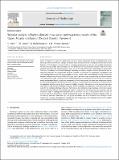Por favor, use este identificador para citar o enlazar a este item:
http://hdl.handle.net/10261/343652COMPARTIR / EXPORTAR:
 SHARE SHARE
 CORE
BASE CORE
BASE
|
|
| Visualizar otros formatos: MARC | Dublin Core | RDF | ORE | MODS | METS | DIDL | DATACITE | |

| Título: | Wavelet analysis of hydro-climatic time-series and vegetation trends of the Upper Aragón catchment (Central Spanish Pyrenees) |
Autor: | Juez, Carmelo CSIC ORCID ; Garijo, N.; Nadal-Romero, Estela CSIC ORCID ; Vicente Serrano, Sergio M. CSIC ORCID | Palabras clave: | River discharge Climate change Greenness Wavelet analysis Water management Mediterranean catchments |
Fecha de publicación: | nov-2022 | Editor: | Elsevier | Citación: | Journal of Hydrology 614(Part B): 128584 (2023) | Resumen: | Water managers and researchers noted with concern a nearly generalized decline in Mediterranean rivers discharge over the last decades. Changes in climatic forces (precipitation and air temperature) and land use and land cover (LULC) changes characterized by re-vegetation and greenness are the two most possible explanations for this discharge decline. The direct impact on river discharge stemming from these changes is difficult to assess and their role is generally studied separately. Here, we use the method of wavelet transformation to interpret the time-scale dependency of catchment discharge concerning the uneven temporal climatic fluctuations and re-vegetation processes. We analyzed the temporal variation of concurrent air temperature, precipitation and river discharge time-series for the Upper Aragón catchment, located in the Central Spanish Pyrenees. A long-term database collected over 60 years (1956–2020) was used. Land cover maps corresponding to different decades were used and the results indicated that the catchment experienced a significant increase in the area covered by mixed and broadleaf forests, mostly as a consequence of land abandonment. We show how temperature slightly increased and precipitation moderately decreased. However, catchment discharge experienced a sharp decline in its magnitude and also changes in its temporal variability dynamics. The relevance of the seasonal time-scales with regard to the available discharge is reduced, which strengthens the importance of the inter-annual time-scales for the catchment discharge dynamics. Furthermore, the catchment storage-discharge cycle at inter-annual time-scales is also reduced. Such changes can mostly be attributed to the changes in plant coverage, with an increasing weight in shaping hydrological processes at catchment scale due to the greenness effect. As such, we conclude that LULC changes have played a dominant role on the river discharge dynamics. Climatic trends, on the contrary, have been small, and they have played a secondary role in the decline of river discharge. Future research can use these observations to constrain the pace of upcoming water demands based on the available water resources at Mediterranean catchment scale. | Versión del editor: | https://doi.org/10.1016/j.jhydrol.2022.128584 | URI: | http://hdl.handle.net/10261/343652 | DOI: | 10.1016/j.jhydrol.2022.128584 | ISSN: | 0022-1694 | E-ISSN: | 1879-2707 |
| Aparece en las colecciones: | (IPE) Artículos (EEAD) Artículos |
Ficheros en este ítem:
| Fichero | Descripción | Tamaño | Formato | |
|---|---|---|---|---|
| Wavelet_JH_2023.pdf | 8,35 MB | Adobe PDF |  Visualizar/Abrir |
CORE Recommender
SCOPUSTM
Citations
7
checked on 21-abr-2024
WEB OF SCIENCETM
Citations
2
checked on 21-feb-2024
Page view(s)
30
checked on 27-abr-2024
Download(s)
18
checked on 27-abr-2024
Google ScholarTM
Check
Altmetric
Altmetric
Este item está licenciado bajo una Licencia Creative Commons

